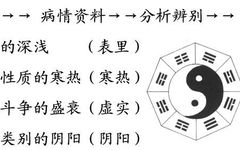Eight Principles of Differentiation The Eight Principles: These are the eight categories of differentiation: Exterior, Interior, Cold, Heat, Deficiency, Excess, Yin, and Yang.
The Eight Principles of Differentiation: This method involves the physician analyzing various clinical data obtained through diagnostic methods using the Eight Principles to determine the depth of the pathological changes, the nature of the condition (Cold or Heat), the balance of pathogenic and righteous Qi, and the categories of syndromes (Yin and Yang). This method is referred to as the Eight Principles of Differentiation.
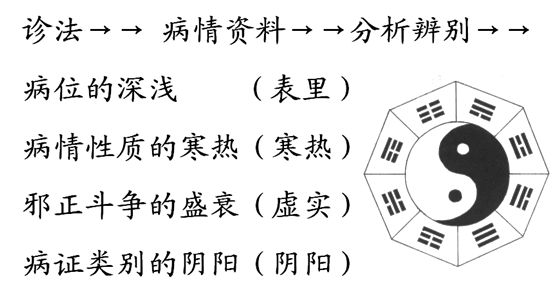 1. Exterior and Interior Differentiation
1. Exterior and Interior Differentiation
Exterior and Interior are a pair of principles that summarize and differentiate the location of diseases as superficial or deep. They can help assess the severity and progression of the condition.Exterior and Interior differentiation is applicable to externally contracted diseases, especially in the early stages of febrile diseases. The main functions of this differentiation are twofold: first, to distinguish severity, where exterior syndromes are superficial and mild, while interior syndromes are deep and severe; second, to determine progression or regression, where exterior pathogens entering the interior indicate disease progression, and interior pathogens exiting to the exterior indicate disease regression. (1) Exterior SyndromeExterior syndrome refers to the superficial symptoms resulting from the invasion of external pathogens such as the Six Excesses, epidemics, or insect toxins, where the righteous Qi (Wei Qi) is resisting the pathogens. This is seen in the early stages of externally contracted diseases.Clinical characteristics: Sudden onset, mild condition, superficial location, short duration, exposure to external pathogens.Clinical manifestations of exterior syndrome:Main manifestations: Chills (or aversion to wind), fever (or subjective feeling of no fever), body aches, floating pulse.Characteristic manifestations: Nasal congestion, clear nasal discharge, or sneezing.Possible symptoms: Scratchy or sore throat, slight cough.General manifestations: Pale red tongue, thin coating. (2) Interior SyndromeInterior syndrome generally refers to pathological changes occurring within the internal organs, reflected by symptoms related to the organs, Qi, blood, and bone marrow. Any condition that does not fall under exterior syndrome or half exterior and half interior syndrome is categorized as interior syndrome. It is often seen in chronic internal injuries or in the later stages of externally contracted diseases.Clinical characteristics: Deep location, severe condition, prolonged duration.Clinical manifestations of interior syndrome:Not aversive to wind or cold, pulse is not floating, tongue quality and coating show changes, and may also present with signs of organ dysfunction (see organ differentiation for details).
(3) Half Exterior and Half Interior Syndrome
Half exterior and half interior syndrome is referred to as Shaoyang syndrome in the Six Meridians differentiation. It indicates a condition where the external pathogen is transitioning into the interior, leading to a struggle between the pathogenic and righteous Qi, with the disease location fluctuating between exterior and interior.Main characteristics include alternating chills and fever, fullness in the chest and hypochondria, irritability, aversion to food, bitter taste in the mouth, dry throat, dizziness, and wiry pulse.
(4) Differentiation of Exterior and Interior Syndromes 2. Cold and Heat Differentiation
2. Cold and Heat Differentiation
Cold and Heat are a pair of principles that summarize and differentiate the nature of diseases. Cold and Heat reflect the balance of Yin and Yang in the body.
Excess: Yang excess leads to Heat… Yang HeatExcessive Yang leads to true Heat;
Excessive Yin leads to Cold… Excessive Yin leads to true Cold.Deficiency: Yang deficiency leads to Cold… Yang Qi deficiency results in false Cold; Yin deficiency leads to Heat… Yin fluid deficiency results in false Heat.Cold syndrome refers to a set of symptoms and signs that are characteristic of cold, while Heat syndrome refers to a set of symptoms and signs that are characteristic of heat.
Illustration of Yin and Yang Balance
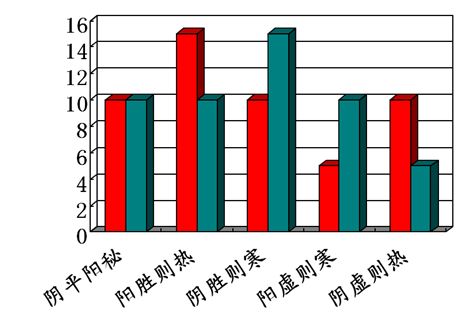
(1) Cold Syndromerefers to a category of syndromes characterized by Yang deficiency and excessive Yin, or the invasion of cold pathogens, presenting a cold nature.1. Definition: Excessive Yin ~ true Cold syndrome, Yang deficiency ~ false Cold syndrome.2. Clinical manifestations:
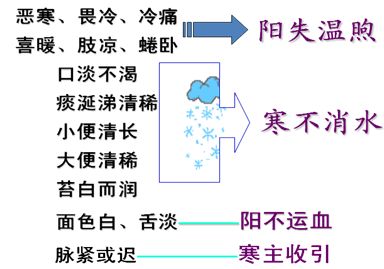
(2) Heat Syndromeis characterized by Yin deficiency and Yang excess, or the invasion of heat pathogens, presenting a hot nature.1. Definition: Yang excess ~ true Heat syndrome, Yin deficiency ~ false Heat syndrome.2. Clinical manifestations:
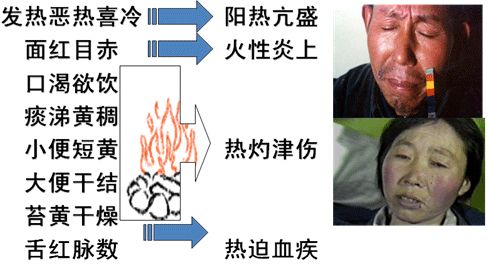
(3) Key Points for Differentiating Cold and Heat Syndromes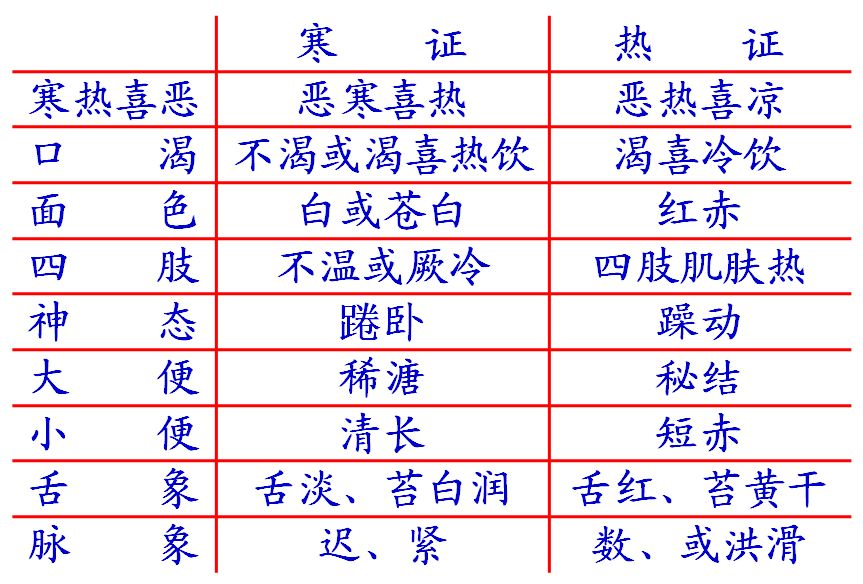
3. Deficiency and Excess Differentiation
Deficiency and Excess summarize and differentiate the strength of the body’s righteous Qi and the weakness of the pathogenic Qi. According to the Suwen, “When the pathogenic Qi is strong, it is Excess; when the vital Qi is depleted, it is Deficiency.” (1) Deficiency SyndromeDeficiency syndrome refers to various syndromes characterized by weakness and insufficiency of the body’s righteous Qi.1. Definition: Righteous Qi deficiency (the main aspect of contradiction), pathogenic Qi is not strong, and the struggle between pathogenic and righteous Qi is not intense.Righteous Qi includes: Yin, Yang, Qi, blood, essence, and body fluids.Degree of deficiency: Insufficient — Deficient — Weak — Declining — Exhausted2. Causes:
(1) Congenital insufficiency
(2) Acquired imbalance and disease consumptionCharacteristics: Prolonged course, slow progression, and a generally weak constitution.Yang deficiency: Yang deficiency refers to a category of syndromes characterized by insufficient Yang Qi (Qi deficiency + cold signs). Symptoms include fatigue, pale complexion, spontaneous sweating, reluctance to speak, aversion to cold, cold limbs, clear and frequent urination, loose stools, pale and enlarged tongue with tooth marks, and weak or thin pulse.Yin deficiency: Yin deficiency refers to a category of syndromes characterized by insufficient Yin fluids (blood deficiency + heat signs). Symptoms include weight loss, dizziness, insomnia, flushed cheeks, five-center heat, dry mouth and throat, tidal fever, night sweats, red tongue with little coating, and thin rapid pulse.
Key Points for Differentiating Yin and Yang Deficiency
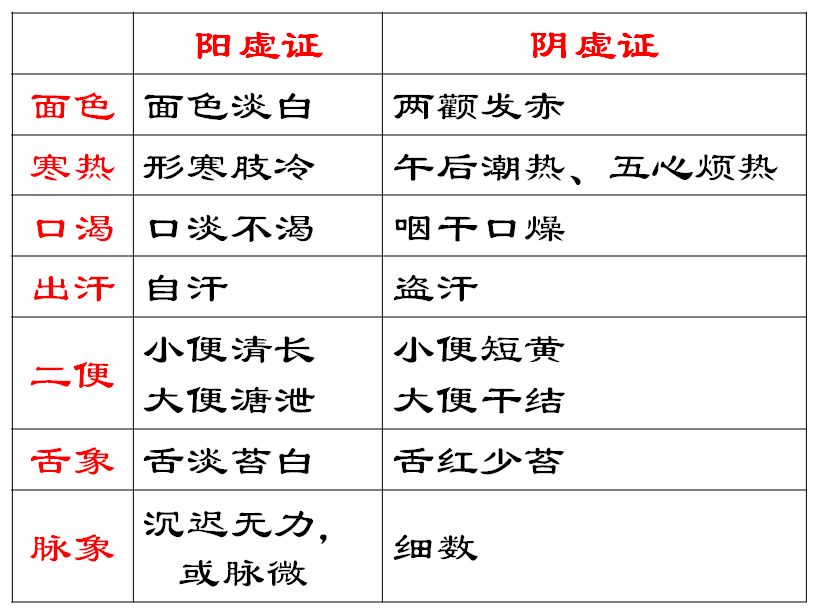 (2) Excess SyndromeExcess syndrome refers to various clinical syndromes characterized by the invasion of external pathogens or the imbalance of Yin and Yang Qi during the disease process, primarily manifesting as Yang, Heat, Stagnation, or Obstruction, or the accumulation of pathological products within the body.1. Definition: (1) Pathogenic Qi is excessive (in excess), righteous Qi is not deficient, and the struggle between pathogenic and righteous Qi is intense. (2) Accumulation of pathological products.2. Causes: (1) Invasion of external pathogens (2) Dysfunction of internal organs, leading to the accumulation of phlegm, dampness, blood stasis, pus, food retention, or parasites. Characteristics: Sudden onset, severe condition, and a robust constitution. Due to the nature of the pathogenic factors, pathological products, and disease location, clinical manifestations are diverse. Symptoms include high fever, abdominal distension and pain, chest tightness and irritability, and in severe cases, confusion, coarse breathing, excessive phlegm, constipation, and difficult urination, with a pale tongue and thick greasy coating, and a strong pulse.
(2) Excess SyndromeExcess syndrome refers to various clinical syndromes characterized by the invasion of external pathogens or the imbalance of Yin and Yang Qi during the disease process, primarily manifesting as Yang, Heat, Stagnation, or Obstruction, or the accumulation of pathological products within the body.1. Definition: (1) Pathogenic Qi is excessive (in excess), righteous Qi is not deficient, and the struggle between pathogenic and righteous Qi is intense. (2) Accumulation of pathological products.2. Causes: (1) Invasion of external pathogens (2) Dysfunction of internal organs, leading to the accumulation of phlegm, dampness, blood stasis, pus, food retention, or parasites. Characteristics: Sudden onset, severe condition, and a robust constitution. Due to the nature of the pathogenic factors, pathological products, and disease location, clinical manifestations are diverse. Symptoms include high fever, abdominal distension and pain, chest tightness and irritability, and in severe cases, confusion, coarse breathing, excessive phlegm, constipation, and difficult urination, with a pale tongue and thick greasy coating, and a strong pulse.
(3) Key Points for Differentiating Deficiency and Excess Syndromes
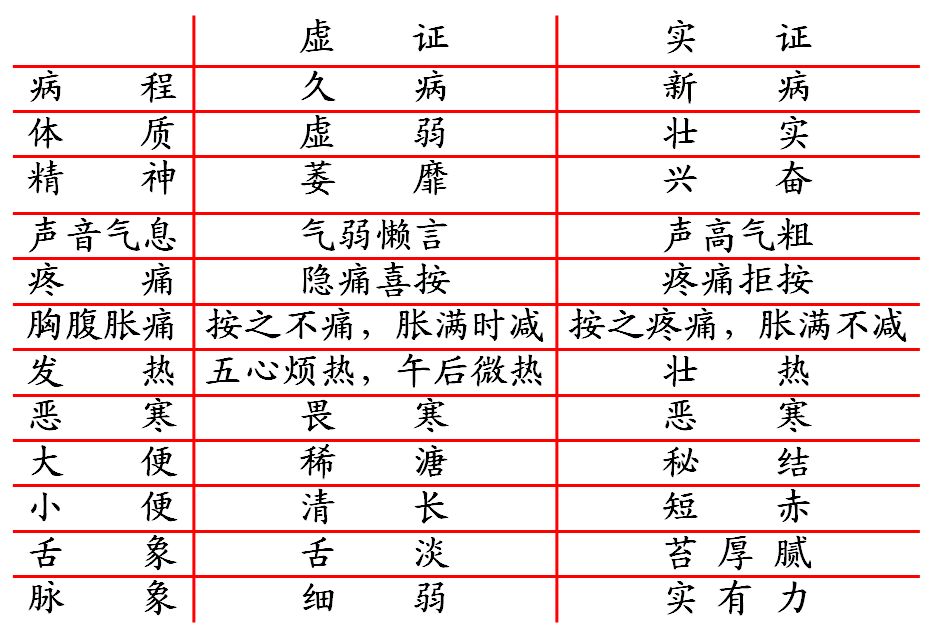 4. Yin and Yang Differentiation
4. Yin and Yang Differentiation
Yin and Yang summarize and differentiate the categories of diseases and syndromes, serving as the overarching principle of the Eight Principles of Differentiation.
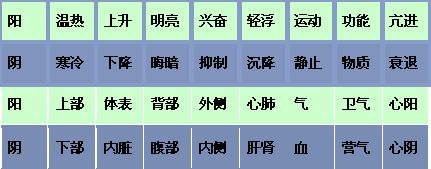
(1) Significance of Yin and Yang Differentiation1. Yin and Yang serve as the overarching principle of the Eight Principles of Differentiation, encompassing the other six aspects (two principles and six essentials).2. Any disease and syndrome can be fundamentally summarized from the perspective of Yin and Yang.Clinical manifestations of Yin and Yang syndromes:1. Yin syndrome: A combination of interior, cold, and deficiency syndromes.2. Yang syndrome: A combination of exterior, heat, and excess syndromes.
(2) Key Points for Differentiating Yin and Yang Syndromes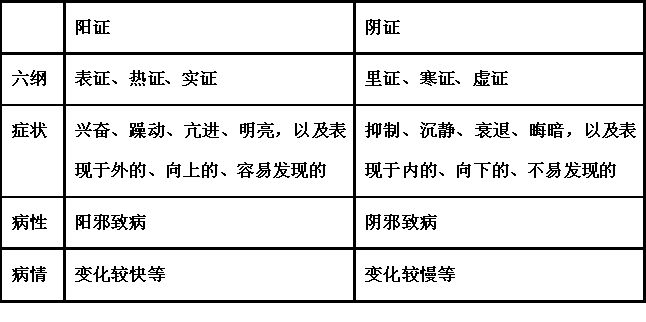
(3) Specific Content of Yin and Yang Differentiation
Key Points for Differentiating Yang Deficiency and Yin Deficiency
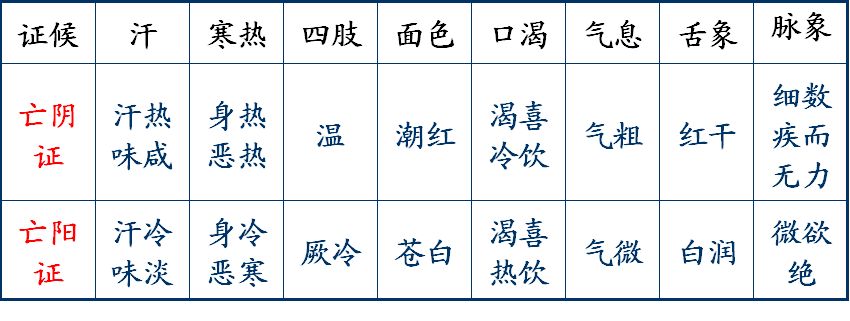
1. Yang Deficiency Syndrome: This syndrome refers to a critical condition where the Yang Qi in the body is extremely weak, leading to symptoms of impending Yang collapse. Symptoms include profuse cold sweat, thin and pale sweat, dull expression, cold skin, cold hands and feet, weak breathing, pale complexion, moist and pale tongue, and a faint pulse.
2. Yin Deficiency Syndrome: This syndrome refers to a critical condition characterized by significant loss of body fluids and severe deficiency of Yin fluids. Symptoms include hot, sticky sweat, like oil, burning sensation in the body, irritability, aversion to heat, thirst, wrinkled skin, very little urination, red complexion, dry lips and tongue, and rapid thin pulse.

● 61 high-definition images of tongue diagnosis and their clinical significance!
● 78 ancient pulse diagnosis methods that were kept secret.
● Three-character formula for Chinese medicine, recommended for collection.
● Common emergency methods in TCM.
● Insights on self-study in TCM (with book list)
● Free access to the complete teaching materials of “Dong’s Unique Acupoints”
END
Shennong Medical Family
Focusing on TCM, more valuable content

Share | Like | Click to view
Support the editor~
Like “👍” and “View” below

